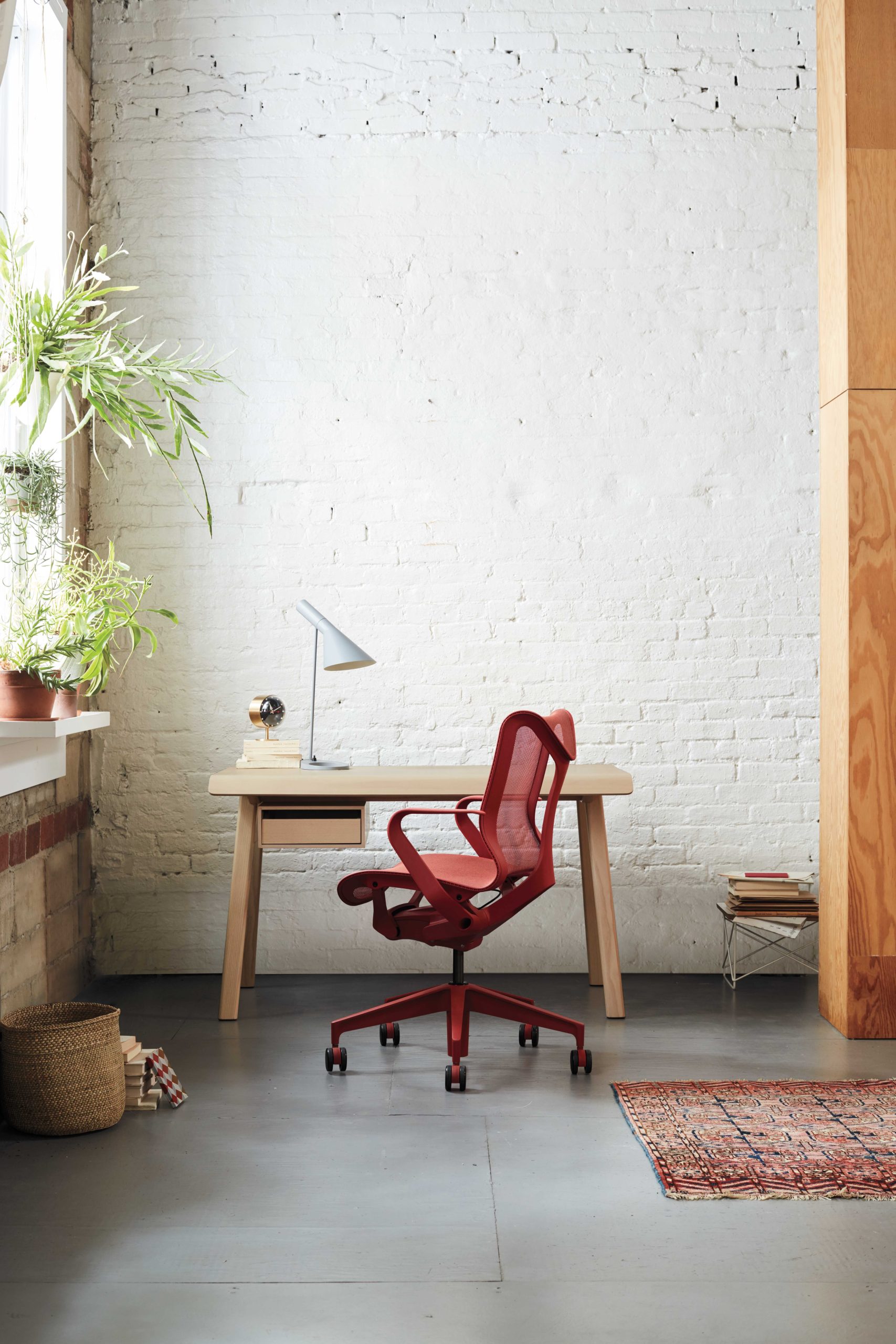The sustainability trend coming to an office near you
It lends a whole new meaning to the concept of hot desking
Everyone is talking about environmental sustainability these days. From growing our own food to opting for less plastic packaging, there is an increasing desire to embrace practices that have as little impact on the environment as possible.
One of the last sectors to seriously consider the way their behaviours are contributing to waste is the office.
Prior to COVID, most offices were refurbished every five to seven years, in line with leasing arrangements. However, quality office furniture can come with warranties of 10 or more years. What to do with used – but still useful – furniture at the end of a lease has been a challenge.
The result is 35,000 tons of furniture from Australian offices ends up in landfill every year.

Designer furniture retailer Living Edge is calling on businesses to end the waste with a shift from one of purchase to leasing. This would result in the furniture supplier taking responsibility for the product over a lifetime.
Sustainability strategist at Living Edge, Guy Walsh, said while it has been a slow burn convincing businesses, interest has gained pace in a post-COVID, hybrid-working environment.
“We have been talking to the market about the life cycle model since 2016,” Mr Walsh said. “But in the last 12 months, we have seen an increase in interest, how it works and the sustainability benefits.”
He puts this down in part to the number of businesses committing to sustainability targets, sometimes without a plan for how to achieve them.
“The big organisations are all making their sustainability pledges and they are working out how to deliver them later,” he said. “You can’t just make claims anymore – you have to provide evidence. We can pull a report out and demonstrate the outcomes, which can be useful for external and internal communications.”
With many workers reluctant to return to the office full time, Mr Walsh said the need for a floor full of office furniture has also changed. A leasing model offers flexibility.
“One of the things COVID created was uncertainty, which requires more agility (from businesses),” he said. “We have promoted that concept around the life cycle model, which has a lot more agility than a traditional model.
“If the world changes, as it has in recent years, you need a strategy for what to do with those assets. One top of that, through a sustainability lens, change can often result in waste.”
Living Edge is the main distributor for Herman Miller, which has built its reputation on the high quality, ergonomic task chairs favoured by big business.
Mr Walsh said the chairs, such as the Aeron, come with a 12-year warranty. Under a leasing arrangement, businesses could return their chairs to Living Edge where they will be triaged according to useability under their LivingOn scheme.
“The top outcome is it gets refurbished and reused by the original purchaser,” he said. “The next option is we refurbish it and we resell it as a ‘second life’ chair. The next option is to recycle the parts. The last, and least attractive option is that it goes to landfill.”
It’s good news for commercial landlords, as well as tenants but it does require a different approach from the standard office fit out. One concern is how to ensure furniture is identifiable by the supplier as theirs. The other is a structural change in how budgets are created and managed.
“One of the big barriers traditionally is that furniture falls under capital expenditure but a lease model would put it under operational expenditure,” he said. “You are moving the cost from a one-off figure to ongoing. It is purely the legacy of how furniture has been bought for office spaces.”
While the model is still in its infancy both here and in Europe, Mr Walsh said there are already signs that it is the way of the future.
“We have heard examples of it happening in Europe but to my knowledge, we haven’t seen that ‘lift off’ moment,” he said.
This stylish family home combines a classic palette and finishes with a flexible floorplan
Just 55 minutes from Sydney, make this your creative getaway located in the majestic Hawkesbury region.
The remote northern island wants more visitors: ‘It’s the rumbling before the herd is coming,’ one hotel manager says
As European hot spots become overcrowded , travellers are digging deeper to find those less-populated but still brag-worthy locations. Greenland, moving up the list, is bracing for its new popularity.
Aria Varasteh has been to 69 countries, including almost all of Europe. He now wants to visit more remote places and avoid spots swarmed by tourists—starting with Greenland.
“I want a taste of something different,” said the 34-year-old founder of a consulting firm serving clients in the Washington, D.C., area.
He originally planned to go to Nuuk, the island’s capital, this fall via out-of-the-way connections, given there wasn’t a nonstop flight from the U.S. But this month United Airlines announced a nonstop, four-hour flight from Newark Liberty International Airport in New Jersey to Nuuk. The route, beginning next summer, is a first for a U.S. airline, according to Greenland tourism officials.
It marks a significant milestone in the territory’s push for more international visitors. Airlines ran flights with a combined 55,000 seats to Greenland from April to August of this year, says Jens Lauridsen, chief executive officer of Greenland Airports. That figure will nearly double next year in the same period, he says, to about 105,000 seats.
The possible coming surge of travellers also presents a challenge for a vast island of 56,000 people as nearby destinations from Iceland to Spain grapple with the consequences of over tourism.
Greenlandic officials say they have watched closely and made deliberate efforts to slowly scale up their plans for visitors. An investment north of $700 million will yield three new airports, the first of which will open next month in Nuuk.
“It’s the rumbling before the herd is coming,” says Mads Mitchell, general manager of Hotel Nordbo, a 67-room property in Nuuk. The owner of his property is considering adding 50 more rooms to meet demand in the coming years.
Mitchell has recently met with travel agents from Brooklyn, N.Y., South Korea and China. He says he welcomes new tourists, but fears tourism will grow too quickly.
“Like in Barcelona, you get tired of tourists, because it’s too much and it pushes out the locals, that is my concern,” he says. “So it’s finding this balance of like showing the love for Greenland and showing the amazing possibilities, but not getting too much too fast.”
Greenland’s buildup
Greenland is an autonomous territory of Denmark more than three times the size of Texas. Tourists travel by boat or small aircraft when venturing to different regions—virtually no roads connect towns or settlements.
Greenland decided to invest in airport infrastructure in 2018 as part of an effort to expand tourism and its role in the economy, which is largely dependent on fishing and subsidies from Denmark. In the coming years, airports in Ilulissat and Qaqortoq, areas known for their scenic fjords, will open.
One narrow-body flight, like what United plans, will generate $200,000 in spending, including hotels, tours and other purchases, Lauridsen says. He calls it a “very significant economic impact.”
In 2023, foreign tourism brought a total of over $270 million to Greenland’s economy, according to Visit Greenland, the tourism and marketing arm owned by the government. Expedition cruises visit the territory, as well as adventure tours.
United will fly twice weekly to Nuuk on its 737 MAX 8, which will seat 166 passengers, starting in June .
“We look for new destinations, we look for hot destinations and destinations, most importantly, we can make money in,” Andrew Nocella , United’s chief commercial officer, said in the company’s earnings call earlier in October.
On the runway
Greenland has looked to nearby Iceland to learn from its experiences with tourism, says Air Greenland Group CEO Jacob Nitter Sørensen. Tiny Iceland still has about seven times the population of its western neighbour.
Nuuk’s new airport will become the new trans-Atlantic hub for Air Greenland, the national carrier. It flies to 14 airports and 46 heliports across the territory.
“Of course, there are discussions about avoiding mass tourism. But right now, I think there is a natural limit in terms of the receiving capacity,” Nitter says.
Air Greenland doesn’t fly nonstop from the U.S. because there isn’t currently enough space to accommodate all travellers in hotels, Nitter says. Air Greenland is building a new hotel in Ilulissat to increase capacity when the airport opens.
Nuuk has just over 550 hotel rooms, according to government documents. A tourism analysis published by Visit Greenland predicts there could be a shortage in rooms beginning in 2027. Most U.S. visitors will stay four to 10 nights, according to traveler sentiment data from Visit Greenland.
As travel picks up, visitors should expect more changes. Officials expect to pass new legislation that would further regulate tourism in time for the 2025 season. Rules on zoning would give local communities the power to limit tourism when needed, says Naaja H. Nathanielsen, minister for business, trade, raw materials, justice and gender equality.
Areas in a so-called red zone would ban tour operators. In northern Greenland, traditional hunting takes place at certain times of year and requires silence, which doesn’t work with cruise ships coming in, Nathanielsen says.
Part of the proposal would require tour operators to be locally based to ensure they pay taxes in Greenland and so that tourists receive local knowledge of the culture. Nathanielsen also plans to introduce a proposal to govern cruise tourism to ensure more travelers stay and eat locally, rather than just walk around for a few hours and grab a cup of coffee, she says.
Public sentiment has remained in favour of tourism as visitor arrivals have increased, Nathanielsen says.
—Roshan Fernandez contributed to this article.
This stylish family home combines a classic palette and finishes with a flexible floorplan
Just 55 minutes from Sydney, make this your creative getaway located in the majestic Hawkesbury region.


















